 Velazquez Collection
Velazquez Collection
 Velazquez Collection
Velazquez Collection
I believe I will keep up this site owing to the number of links to it that have developed over the years, but there is now a much better Velazquez collection at the Web Museum.
Sadly, the requirements of his position as a court painter mean that all too many of his portraits are of members of one of the most certifiably ugly royal families in human history.
All of these selections reside at the Prado in Madrid.
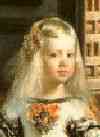 Las Meninas (1656) 773x881 JPEG
Las Meninas (1656) 773x881 JPEG
Perhaps his greatest work. Perhaps just the greatest painting, period.
The title until the 19th century was "The Royal Family". (Look for
their Majesties in the mirror).
"Meninas" means, roughly, "ladies-in-waiting", young nobles who attend
the princess, the Infanta Maria Teresa (later married to Louis XIV of
France). Sadly, she outgrew the cute phase and came to look like
the rest of the family. My favourite character? I agree with my niece
in Spain, who has gazed at this enormous masterpiece for hours: the dog, the
beautiful old dog so tolerant of his abuser, is fantastic.
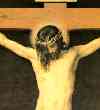
Christ on the Cross (1630's) 663x1013 JPEG
Velazquez, for whatever reason (perhaps not confessable in ardently
Catholic 17th-century Spain) did comparatively little religious art.
However, this piece, proof that he had assimilated all the best of
the Venetian school and brought to it perfections of his own, has been
called "the perfect representation of Christ".
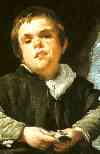
El Nino do Vallecas (between 1636-46) 727x947 JPEG
The proper name now given this work is "The Dwarf Francisco Lezcano";
much debate over the centuries has left some question of which of
the royal family's (let us be frank) "pet dwarves" this young man
was, or exactly when he was painted. Well, heck, his job beat begging
in the streets, and he got to be immortalized with a tremendously
sympathetic portrait. Velazquez had an amazing ability to find
beauty and dignity beneath the surface of appearance.
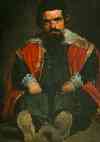
The Dwarf Sebastian de Morra (1636) 436x579 JPEG
Some think this portrait his most beautiful. It is certainly more
experimental than the formal ones of the royals, with the "wet-on-wet"
painting technique that gives the face such a depth of light and shadow.
This is my personal favourite. There seems to be more humanity and even
nobility in those eyes than in all of the royal family.
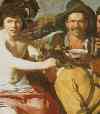
Los Borrachos (1627) 773x554 JPEG
Also called "The Feast of Bacchus", "Los Borrachos" translates as "The
Drunkards". The figure of Bacchus (centre) could have stepped from a
mythological study, but the rest of the characters are soldiers and peasants
of the time of the artwork, giving the roaring party an intense immediacy.
Another favourite, but for a silly reason: I can't get over how much
the guy just right of centre looks like the late cowboy actor Slim Pickens.